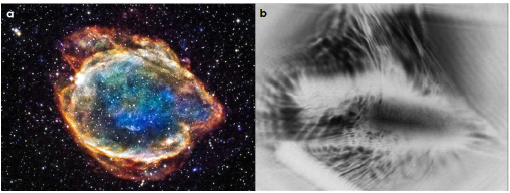Speaker: Professor Kazuhisa Nakajima, High Energy Accelerator Research Organization(KEK), Japan
Time: 10:15 am, August 6, 2018
Venue:Lecture Hall of No. 3rd Building (West Campus)
Abstract: Collisionless shocks and collective beam-plasma instabilities are of great interest in investigation of novel inertial confinement fusion and a wide range of astrophysical phenomena, for instance, cosmic ray acceleration, supernova remnants (Fig.1a), accreting black hole systems, active galactic nuclei and gamma-ray bursts, as well as in potential applications such as hadron therapy. The experiment on interactions of ultraintense laser pulses with near critical density plasmas has been performed, using a 1 PW laser with a 30 J energy and 30fs duration, focused on the high density gas jet producing a plasma density of >1020 cm-3. Here we show for the first time in-situ observation of shock formation associated with transition from electrostatic to electromagnetic shocks (Fig,1b), self-generated magnetic fields, ion and electron accelerations. The analysis of collective beam-plasma instabilities revealed the unstable oblique modes of selfgenerated magnetic fields as well as the Weibel-type instability, of which growing filamentary structures were visually demonstrated in the experiment. Measured spectra of particle acceleration on He ions, protons and electrons exhibit their distinct spectral features by comparison between electrostatic and electromagnetic dominant cases. The particle acceleration mechanism for the electromagnetic dominant case may be conjectured as the Fermi acceleration mechanism in conjunction with the Weibel instability-mediated collisionless shocks. Ultrafast laser-plasma experiments to explore microphysics of collisionless shocks provide in-depth insights into many astrophysical phenomena. In this talk, the recent results on 4 PW laser wakefield electron acceleration beyond 5 GeV will be reported.

Fig. 1 (a) The supernova remnant called G299, as seen by NASA’s Chandra X-ray observatory.
(b) Collisionless shocks observed in the present experiment.